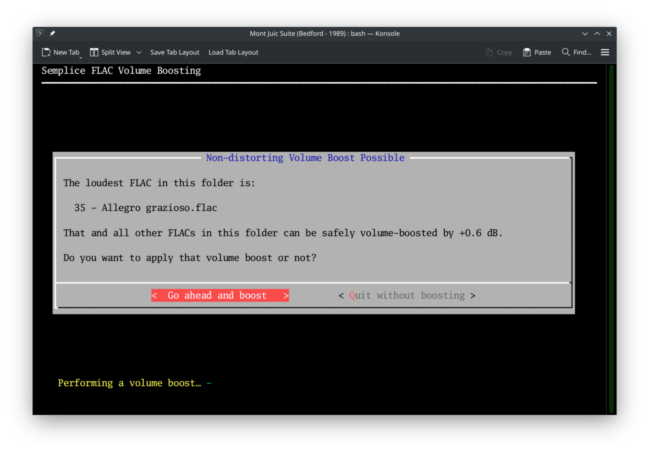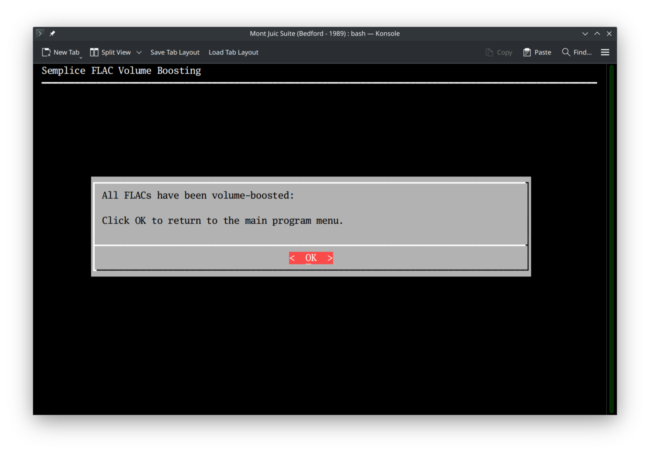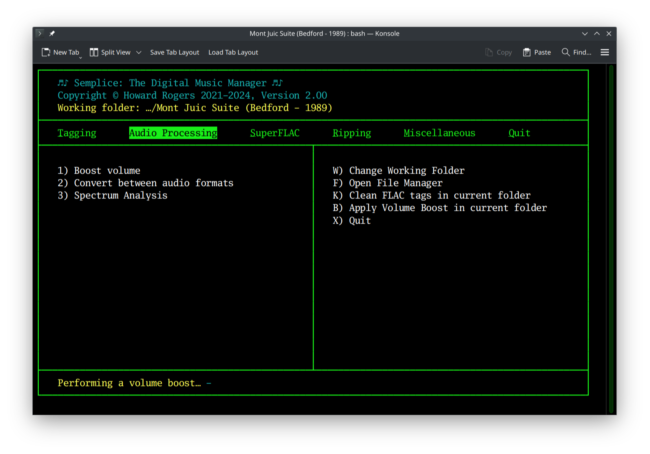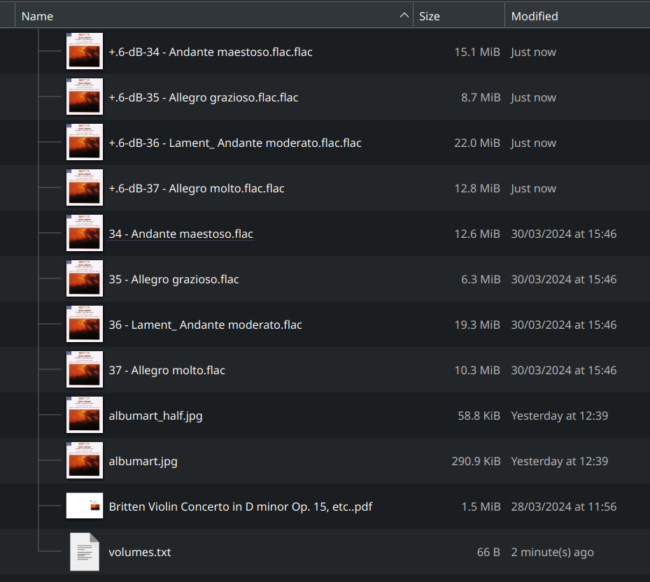1.0 Introduction
SACDs use a digital format called 'Direct Stream Digital' (or DSD). This uses 'pulse-density modulation' (PDM) to convey musical or sound information; traditional CDs use 'pulse-code modulation' (PCM). The difference between the two encoding technologies is substantial and, obviously, very tricky to describe in simple terms (but I had a go here: if PCM is like a wave going up and down on a pond, PDM is like a longitudinal wave travelling along a spring or slinky). Those fundamental differences in nature make it very difficult, too, to convert something in PDM to PCM accurately and precisely. It's like trying to translate Italian to English: you'll mostly do OK, but some subtleties will be lost in the translation. In particular, absolute peak volumes are difficult to match between the two technologies, such that what PCM thinks is a non-distorting volume of 0dB, PDM will translate as something like +3dB, well into the distorting and clipping region of screwing things up badly! The engineers compensate for this by backing off the value of PDM signals by a modest amount, so that there's no danger of a PDM peak ever being converted into an above-zero PCM/analog peak volume. Typically, SACDs are therefore mastered at around -6dB, compared to what you'd expect from a standard CD, in this attempt to suppress distorting peak volumes. It's not true for every SACD, it has to be said: the technology has improved over the years and more accurate peak management of PDM signals provide less risky volume issues these days. Nevertheless, a -6dB mastering level has become something of an unofficial standard by now.
This, of course, poses practical issues. You listen to a rip of a standard CD at a good level and everything sounds fine; you then start playing a rip from an SACD and wonder why everyone seems to be whispering! So you crank up your amplifier's volume knob to make things acceptable once more... only to have the next piece of ripped-from-an-ordinary-CD music blast your eardrums as being waaay to loud! Rather than constantly having to adjust the volume knob, how about we just adjust the volume of the audio signal in the digital file itself? That, of course, is exactly what Semplice's Audio Processing menu, Option 1 allows us to do. It's also entirely safe to do, because at this point, we're just dealing with FLACs that have been created from the SACD data: the conversion from PDM to PCM has already happened, so we can adjust PCM absolute volume levels without the risk of re-introducing inappropriate PDM peak volume spikes.
In short, for various technical reasons, SACDs are often mastered at significantly quieter volumes than their standard CD equivalents: applying a volume boost to FLACs ripped from SACDs is a safe, non-distorting way to correct this technical outcome.
With all that said, volume boosting is not something that only applies to SACD rips. Let's say you buy a perfectly ordinary audio CD with, for example, three different compositions on it. You'll often find that the mastering of such a CD is done in such a way as to achieve an overall 'loudness' for the CD as a whole: the record company doesn't want you nodding off during the first piece and then having the shock of your life when the second one kicks in! To achieve that 'overall volume' for the CD as a whole, some works on the CD will be mastered at a deliberately lower volume than they otherwise might be. Which is fine if you're playing an entire CD, but Semplice is all about ripping CDs to FLACs and storing each 'composition' found on the CD in its own folder. Now you don't have a single 'thing' to which an 'average' volume can be meaningfully applied: you've got three separate things which could be played in isolation from each other. In these situations, therefore, the quieter recordings on the original CD can be usefully volume boosted to be about as loud as everything else you listen to. Volume boosting is thus something that can be useful for non-SACD rips, just as much for SACD ones.
Semplice's volume-boosting algorithm measures the peak volume of each FLAC found in the working folder. With 0dB being the non-distorting maximum value, each FLAC's peak volume is compared to that: if it's less than 0dB, it could be increased to be 0dB. However, Semplice always preserves relative loudness amongst FLACs in the same folder. It wouldn't make sense to make the ppp adagio of a symphony as loud as the fff finale, for example: that would be to smudge everything up or down to the same sort of average loudness, which would obviously be very undesirable for classical music. We like our dynamic range! So Semplice does not do that. Instead, it analyses each FLAC in turn and finds their peak loudness. Let's say FLAC 1 is discovered to have a peak loudness of (say) -8dB, FLAC 2 has one of -3dB, and FLAC 3 has one of -13.4dB. Then Semplice simply does the maths and works out that the maximum non-distorting volume boost it can offer is to add +3dB, to bring the second FLAC to its maximum possible volume: if accepted, that same +3dB boost will be applied to all the FLACs in the folder, resulting in peak loudnesses of -5dB, 0dB and -10.4dB. The result is that everything is boosted by an absolute amount of +3dB, but the loudness differences between FLACs is preserved. The quiet parts of a symphony stay relatively quiet, compared to the dramatically loud parts.
In practice, Semplice takes a more conservative approach to volume boosting than I've just described: if it is measured that a +3dB volume boost could be applied, Semplice will only actually offer a +2.5dB boost. It lops off half a decibel from the maximum possible boost just to ensure it stays on the un-distorting side of the volume boost line. For this reason, too, if after analysis Semplice determines that the largest volume boost it can do is less than +0.5dB, it won't bother to prompt you to perform a boost at all (and won't do one automatically itself, either).
One configuration parameter affects the way volume boosting works in Semplice:
If Apply audio boost automatically if appropriate is set to yes, then having analysed the FLACs in the working folder, if Semplice determines that a volume boost greater than +0.5dB can be applied without introducing distortion, it will go ahead and apply that volume boost without asking you. To begin with, though, I'm going to switch my 'apply audio boost' option back to the default value of 'no' and document what happens in that situation.
2.0 Manual Volume Boosting
Before you can volume boost, you need to be working with a folder full of FLACs: that means either launching Semplice from within a folder of FLACs, or pressing 'W' and selecting a 'working folder' full of FLACs from the folder selection dialog that appears. The top of the Semplice main menu tells you when a working folder has been selected correctly:
In this case, I'm working in a sub-folder called 'Mont Juic Suite (Bedford - 1989)'. Once a working folder has been selected, press 1 to enter the volume boosting business:
 The moment you take this menu option, you'll see a message about 'Analysing each of the FLACs in turn…' appear on the bottom line of the main program display. A 'spinner' will indicate progress: if there are a lot of files to analyse, Semplice can take quite a while to work out what to do, so be patient and let it finish its work. Once volume analysis has completed, you'll receive a message such as this:
The moment you take this menu option, you'll see a message about 'Analysing each of the FLACs in turn…' appear on the bottom line of the main program display. A 'spinner' will indicate progress: if there are a lot of files to analyse, Semplice can take quite a while to work out what to do, so be patient and let it finish its work. Once volume analysis has completed, you'll receive a message such as this:
 This message indicates a potential volume boost has been identified and shows you the loudest file and the maximum permitted boost that can be applied to it without introducing distortion. That will be the file you especially want to listen to after the volume boost has been applied, to make sure nothing awful has been introduced into the audiio signal. Note that the amount of the available volume boost is shown after the initial 0.5dB "discount" has been applied. In other words, looking at that screenshot, file 35 can actually be boosted by +1.1dB... but Semplice is telling you that it's only going to apply a +0.6dB boost, because in its mind, it's already lopped off the extra 0.5dB as its safety precaution. You will, therefore, see proposals to boost by 0.2dB or even 0.1dB: that means the analysed volume boost was +0.7dB or +0.6dB, but the message only displays the amount of boost that will actually be applied, not the amount that technically could be.
This message indicates a potential volume boost has been identified and shows you the loudest file and the maximum permitted boost that can be applied to it without introducing distortion. That will be the file you especially want to listen to after the volume boost has been applied, to make sure nothing awful has been introduced into the audiio signal. Note that the amount of the available volume boost is shown after the initial 0.5dB "discount" has been applied. In other words, looking at that screenshot, file 35 can actually be boosted by +1.1dB... but Semplice is telling you that it's only going to apply a +0.6dB boost, because in its mind, it's already lopped off the extra 0.5dB as its safety precaution. You will, therefore, see proposals to boost by 0.2dB or even 0.1dB: that means the analysed volume boost was +0.7dB or +0.6dB, but the message only displays the amount of boost that will actually be applied, not the amount that technically could be.
Obviously there are two options at this point: go ahead and apply the proposed boost, or quit without doing so. If you select the 'quit' option, you will return to the Audio Processing menu and your FLACs will not have been altered at all or adjusted in any way.
If you select the 'Go ahead' option, this happens:
 The little message at the bottom of the screen appears, potentially for several minutes if there are a lot of FLACs in the working folder, telling you that a volume boost is being performed. What does that look like? Well, if you had your file manager open at the same time this was taking place, you'd see this:
The little message at the bottom of the screen appears, potentially for several minutes if there are a lot of FLACs in the working folder, telling you that a volume boost is being performed. What does that look like? Well, if you had your file manager open at the same time this was taking place, you'd see this:
What you see here are the original FLACs named '34 - Andante', '35 - Allegro' and so on, together with a bunch of files modified 'just now' with names such as '+.6-dB-34 - Andante' and '+.6-dB-35 - Allegro' and so on. Obviously the volume-boosted files are the ones with the "+.6" in their file names: that's the maximum volume boost that the earlier screen mentioned could be safely applied. The point here, of course, is that the creation of volume-boosted versions of your FLACs doesn't destroy the originals. The two versions of the music sit together, so that you can easily revert to the non-boosted ones if you don't like the results of volume boosting. Incidentally, too: you'll notice that the original file 34 is 12.6MB in size, whereas the +.6-dB-34 equivalent is 15.1MB: volume boosting by even this modest amount has made the file size increase by 2.5MB (or nearly 20%). Obviously, this all means that when you do volume boosting, you need to have sufficient disk space free to accommodate at least twice the size of the original recording.
Back in Semplice once the volume boost concludes, you'll see this:
With two sets of FLACs now on disk, one volume-boosted and the other original, the question arises as to whether you want to retain the originals. If you answer [Yes] here, the originals will be deleted for you, leaving only the volume-boosted replacements behind. That's obviously something you might not want to commit to, until you're completely comfortable with the whole business of volume-boosting. You're encouraged to listen to the originals and compare them to their boosted cousins: once you're happy that the volume-boosted ones are literally just a bit louder than the originals, but without any added weirdness, distortion or other acoustic horrors, you can feel happy in deleting the originals. If you answer [No] here, you're simply returned to Semplice's Audio Processing menu and both sets of FLACs are left intact on your hard disk, for you to sort out at your leisure.
For now, let me answer [Yes] and take note of what happens. First, in Semplice itself you'd see this message:
 That's just explicit confirmation that "something has happened" and you can press [Enter] or click [OK] to return to the Semplice Audio Processing menu. Secondly, we can return to our file manager and see what has happened to the FLACs on disk:
That's just explicit confirmation that "something has happened" and you can press [Enter] or click [OK] to return to the Semplice Audio Processing menu. Secondly, we can return to our file manager and see what has happened to the FLACs on disk:
The first thing you'll notice is that only half the FLACs remain: we had eight of them before but now only four remain (along with some JPGs and a PDF). So, something's been deleted. A quick glance at the file names might lead you to think that the volume-boosted FLACs had been deleted, because nothing now remaining is called '+.6-dB...'. Pay closer attention to the file sizes however: File 34 is 15.1MB, file 35 is 8.7MB, and so on. Go back a couple of screenshots and you'll see that those were the sizes of the volume-boosted FLACs, not the originals. We can therefore conclude that saying 'yes' to the question about deleting the originals not only triggers the deletion of the original FLACs but also causes file names to be adjusted so that the surviving files acquire the names originally owned by the non-volume-boosted originals.
And that's really all there is to say about volume boosting! Point Semplice at a folder full of FLACs, ask it to analyse them, agree to any proposed boost, delete the originals when it's all over: job done!
3.0 Auto-Boosting
What if the configuration file's Apply audio boost automatically if appropriate parameter is set to yes, though? Does that materially change the way volume boosting works? Somewhat: with auto-boosting on, you don't get asked if you'd like to apply a volume boost. The second you take Option 1 from the Audio Processing menu, this happens:
 That is, the 'Performing a volume boost' message appears at the bottom of the screen automatically. You aren't told what amount of volume boost has been analysed to be possible, nor the name of the loudest file to which the boost will be applied. You aren't even asked whether you want to apply the computed volume boost or not: it just starts happening, entirely without prompting. Once the volume boost has been applied, however, you'll see this:
That is, the 'Performing a volume boost' message appears at the bottom of the screen automatically. You aren't told what amount of volume boost has been analysed to be possible, nor the name of the loudest file to which the boost will be applied. You aren't even asked whether you want to apply the computed volume boost or not: it just starts happening, entirely without prompting. Once the volume boost has been applied, however, you'll see this:
 So you still get to control whether to retain the original FLACs alongside the volume boosted equivalents. If you checked in your file manager, you'd see the mix of files we saw before: files with ordinary names would sit side-by-side with files with '+.xdB' prefixes to their equivalent file names. If you answer [Yes] to the prompt to delete the original FLACs, then the usual sort of filename renaming takes place, so that you are left with 'properly' named files which are, in fact, the volume-boosted versions. In summary, setting the configuration parameter to 'auto-boost' simply removes a prompt message or two: it doesn't fundamentally alter the way volume boosting works and the process remains non-destructive (in that the originals are preserved) right up until the moment when you are explicitly asked to delete the originals.
So you still get to control whether to retain the original FLACs alongside the volume boosted equivalents. If you checked in your file manager, you'd see the mix of files we saw before: files with ordinary names would sit side-by-side with files with '+.xdB' prefixes to their equivalent file names. If you answer [Yes] to the prompt to delete the original FLACs, then the usual sort of filename renaming takes place, so that you are left with 'properly' named files which are, in fact, the volume-boosted versions. In summary, setting the configuration parameter to 'auto-boost' simply removes a prompt message or two: it doesn't fundamentally alter the way volume boosting works and the process remains non-destructive (in that the originals are preserved) right up until the moment when you are explicitly asked to delete the originals.
4.0 Volume Boosting Side Notes
There are just a couple of extra comments to throw in about volume boosting in general.
First, Semplice is hard-coded never to offer to boost more than 7.5dB. If Semplice were able to offer you a boost of, say 10dB, that should raise concerns: why did the recording engineers master this recording so quietlyI?! Whatever their reasons, second-guessing them to the extent of completely reversing their expert opinion seems a bit risky. Practical experience has shown me that the few CDs I have in my collection where such large volume boosts could be offered are terribly recorded! One I can think of consists of organ pieces recorded in Lincoln Cathedral. Sounds fine, if a bit quiet. Volume boost it to around -0.5dB, however, and it sounds utterly dreadful: you can hear footsteps, people chatting (presumably tourists wandering through non-closed off parts of the cathedral), echoes that just sound awful and so on. The recording engineers obviously worked out that if they kept the volume level down, the organ's natural tendency to stand out would let them handle a less-than-perfect background noise level. Charge in and reverse their handiwork, however, and all you have is a nasty mess, not an enjoyable CD of organ works! Realising this is likely a general rule -very quiet recordings usually have a reason for being so quiet- I've therefore hard-coded Semplice to regard anything over 8dB as unacceptably large (and the usual lopped off ½dB means that's +7.5dB in practice).
Second, if you are determined enough, you can subject a recording to multiple volume boosts. Let's say your recording is mastered at -20dB (which, from memory, is about where the Lincoln Cathedral organ one was). Your first volume boost will add 7.5dB to the signal, but that still leaves 12.5dB on the table. So, a second volume boost will again allow you to add another 7.5dB to the signal, leaving a final 5dB available to add during a third boost. I would absolutely not recommend doing more than one volume boost on a recording, however: but it's mathematically possible.
Finally, don't confuse volume boosting with anything you may have heard about 'the loudness wars'. That is or was the business of compressing the dynamic range of a recording so as to make recordings sound louder across the board. Semplice does not compress the dynamic range of anything: it lifts the entire volume of a recording so that its peak is as loud as it can be, but the floor is still as far away from that peak as it ever was. In classical music terms, the loudness wars was about making the entire play fortissimo throughout, ignoring any indications to play mezzo-piano or pianissimo. Semplice's volume boost results in a fortissimo that is probably a fortississimo and a pianissimo which is probably a piano... but there's still dynamic range there!
|[Back to Front Page]|[Tagging Home]|[Audio Processing Home]|[Ripping Standard CDs]|[Ripping SACDs]|[All About SuperFLACs]|



